A unique feature of Sanatan Hindu Dharma is the deep thinking behind acquisition of Chaitanya (Divine consciousness) through every action in human life. Puja (Ritualistic worship) is the simplest ritualistic worship that can be regularly performed in every house. We can easily acquire Chaitanya through this act. If the pujak (Worshipper) is able to generate maximum sattvikta (Purity) in him before the Puja, then he will be able to acquire Chaitanya through the Puja. The pujak’s individual preparation helps increase his sattvikta.
Code of Conduct consisting of an appropriate action is considered to be the foundation of Dharma. The physical body that experiences heaviness due to inertia acquires lightness by performing movements associated with action-oriented conduct. The individual action-oriented preparation before the Puja amounts to understanding the meaning of rituals, reading the scriptures individually, understanding the objective of the rituals and preparing our body to absorb the (pure) frequencies by wearing appropriate clothing and ornaments, which will help attract frequencies.
A. Increase in sattvikta
As a result of the preparation before the Puja, the sattvikta of the pujak increases.
- Due to the increase in sattvikta, there is an increase in the pujak’s capacity to receive the God Principle attracted during the Puja.
- The increase in sattvikta purifies the pujak’s body and helps reduce the black energy within.
B. Preservation of Hindu culture
Practices followed as individual preparation before Puja, like wearing of a dhoti (an unstitched, generally white cotton cloth worn around the waist and covering the body below the waist) and uparna, wearing of a nine-yard saree by women, applying gandh etc. are symbols of Hindu culture which are full of Chaitanya.
Individual preparation required before ritualistic worship is given ahead.
1. Bath
- Whenever possible, bath at reservoirs such as a river, lake, well etc.
- While bathing, use ubtan (fragrant herbal powder, which is applied to the body) and oil or Ayurvedic soap instead of soap made from chemicals.
- Before starting on the bath, pray to the Jaldevta (Deity of water) – ‘O Jaldevta, with your sacred water, let my subconscious mind also become clean and pure along with the external body.’.
- When bathing at home, sit on a wooden stool, with the legs folded and preferably wash the hair too.
- While bathing, continuously chant the Name of the Upasyadevta (Deity of worship).
- Puja should be commenced within one hour of the bath.
2. Pranayam
The pujak should perform pranayam immediately after the bath. As a result of pranayam, the black energy in the body gets destroyed and sattvikta required for performing the Puja is retained for a longer period. Performing pranayam purifies the Pancha-pran (five vital energies) to some extent and destroys the black energy in the body. This further helps in retaining the sattvikta, which has increased as a result of bathing.
3. Clothing
A. Clothing for men
Sovale-uparna
A man should wear a dark colour, preferably red sovale or a Pitambar (yellow silk dhoti) or a Dhootavastra (any clean and washed article of clothing) and wear uparna on his left shoulder. While placing the uparna on the shoulder, the fold should be in front, the loose end should be behind and the border should face outwards. If it is not possible to wear sovale-uparna, a kurta-pyjama (long knee length top and loose pant, a Bharatiya dress) should be worn.
A Topi
A man who does not keep a shikha (a tuft of hair on the head) should wear a Topi (Bharatiya cap used especially during rituals), which is flat and pointed at both the ends. It should be dark in colour, preferably red and made of silk.
B. Clothing for women
Nine-yard saree
Women should wear a nine-yard saree and cover the head with the free end of the saree (this is also known as pallu). If it is not possible to wear a nine-yard saree, then a six-yard saree should be worn.
Wearing of clothes made from natural fibres like cotton and silk is more beneficial. Use of clothes made from polyester, nylon, rayon etc. is not advised because of the effect of Raja-Tama attracting energy in the synthetic fibres. Silk clothes have a greater capacity to imbibe Chaitanya when compared to other clothes.
4. Hair style
A. Hair style for men
It is best if men keep a shikha. Otherwise they should comb their hair neatly with a parting on one side.
B. Hair style for women
Women should preferably make a bun and wear a small garland of flowers on it.
5. Ornaments
A. Ornaments for men
Men should wear a gold chain and a ring on the ring finger of the right hand.
B. Ornaments for women
Women should wear various ornaments all over the body.
The ornaments should be made of gold. If wearing gold ornaments is not possible, then wear ornaments made of silver or other metals. Ornaments worn should be as per individual financial capacity.
6. Applying tilak
A. A man applying tilak to himself or to another man
Kumkum
Apply kumkum (vermillion) vertically on the forehead or Adnya-chakra (situated at midpoint between the brows) using the right hand middle finger.
Gandh
Apply gandh (sandalwood paste) on the Adnya-chakra using the right ring finger.
Shendur
Apply shendur (orange colour powder) at the base of the nose, using the right hand ring finger.
Bukka
Apply bukka (a black powder containing fragrant substances) at the base of the nose, using the right ring finger.
Akshata
Apply Akshata (unbroken rice grains smeared with vermillion) over the kumkum and gandh, using all the fingers.
Bhasma
Apply bhasma using the index, middle and ring fingers of the right hand. Starting from the forehead, apply it on the Vishuddh-chakra, Anahat-chakra and Manipur-chakra in sequence. Then apply it on the face, neck, arms, chest, navel and feet.
Always apply bhasma horizontally and not vertically.
Soil from the banks of Holy rivers or Gopichandan
One or more lines are drawn on the forehead (Urdhvapundra) with the help of these substances using the ring finger.
B. A woman applying tilak to herself
Kumkum
Kumkum should be applied in a circular shape on the Adnya-chakra with the ring finger.
Haldi (Turmeric powder) and kumkum
Haldi should be applied first at the base of the nose with the ring finger and then kumkum applied on the Adnya-chakra above that with the same finger.
C. A woman applying tilak to another woman or man
Kumkum
Apply it in a circular shape on the Adnya-chakra (with the middle finger) to another woman; but apply it vertically (with the middle finger) to a man.
Haldi and kumkum
A woman should apply haldi at the base of the nose with the ring finger and kumkum on the Adnya-chakra with the middle finger, to another woman.

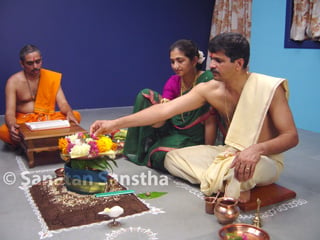 What are the benefits obtained from Puja preparations?
What are the benefits obtained from Puja preparations?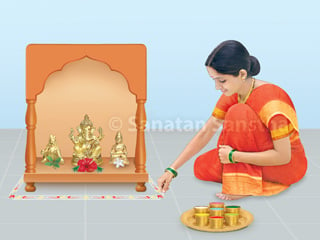 Importance of drawing Rangoli as a part of Puja preparations
Importance of drawing Rangoli as a part of Puja preparations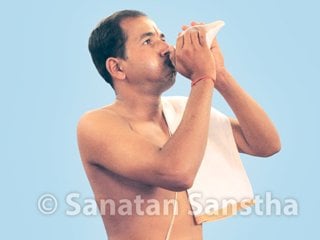 Sounding of a conch at the commencement of a puja
Sounding of a conch at the commencement of a puja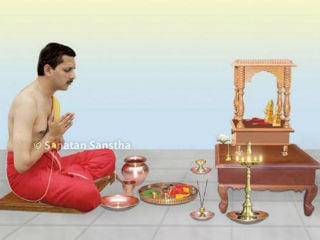 Why are kalash, conch, bell and lamp worshipped before puja ?
Why are kalash, conch, bell and lamp worshipped before puja ?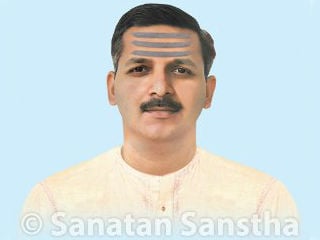 Importance of applying tilak or bhasma by the pujak while performing Puja
Importance of applying tilak or bhasma by the pujak while performing Puja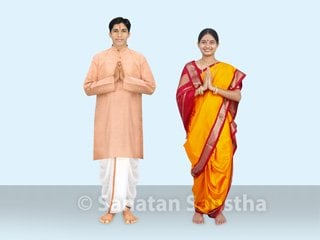 Clothes to be worn by men and women while performing Puja
Clothes to be worn by men and women while performing Puja